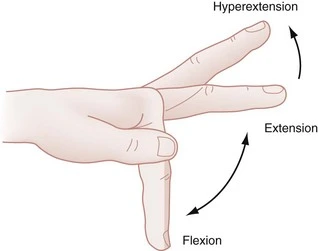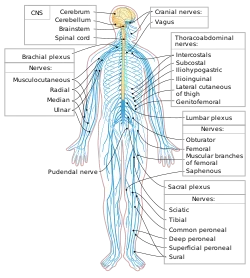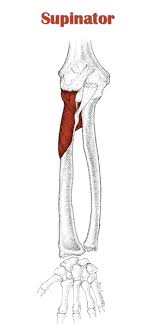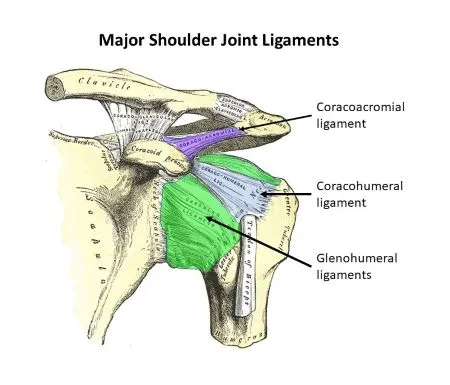Metacarpophalangeal Joint (MCP) Flexion & Extension
Table of Contents
What is a Metacarpophalangeal Joint (MCP) Flexion & Extension?
The Metacarpophalangeal (MCP) joint is a critical anatomical structure located in the hand, forming the connection between the metacarpal bones of the palm and the proximal phalanges of the fingers. These joints are essential for hand function and enable a wide range of movements that are fundamental to everyday activities.
Metacarpophalangeal Joint (MCP) joint flexion and extension are the primary motions that occur at this joint. Flexion refers to the bending of the fingers, bringing them closer to the palm, while extension involves straightening the fingers away from the palm. These actions allow us to grip objects, perform precise manual tasks, and carry out various functional movements.
Maintaining the health and mobility of the Metacarpophalangeal Joint (MCP) joints is crucial for hand dexterity and overall hand function. Injuries, conditions like arthritis, or repetitive strain can impact the joint’s range of motion and lead to discomfort and limitations in daily activities.
Understanding the mechanics of Metacarpophalangeal Joint (MCP) joint flexion and extension and implementing appropriate exercises and therapies can help improve hand strength, flexibility, and overall hand health. Whether in rehabilitation after an injury or as part of preventive measures, keeping the MCP joints in optimal condition is essential for maintaining an active and functional lifestyle.
Metacarpophalangeal Joint (MCP) Flexion
What is Metacarpophalangeal Joint (MCP) Flexion?
Metacarpophalangeal (MCP) joint flexion refers to the flexion motion that occurs between the metacarpal (palmar) and fingers (phalanx). The MCP joints are located at the base of each finger where the phalanges join the hand.
Flexion of the MCP joints allows the fingers to bend or curl into the palm. This movement is crucial for a variety of hand functions, including grasping, grasping, and manipulating objects. The degree of flexion of the MCP joint varies from individual to individual and is regulated by the contraction of the muscles and tendons of the hand and forearm.
In summary, MCP joint flexion refers to the flexion movements of the fingers at the joints that connect the finger bones to the hand.
Metacarpophalangeal Joint (MCP) Flexors Muscle
The metacarpophalangeal (MCP) joint muscles are the muscles responsible for flexing the fingers at the Metacarpophalangeal Joint (MCP) joint. These muscles are located in the palm and forearm. The main MCP flexor muscles are:
- Flexor Digitorum Profundus: This muscle is located on the forearm and goes along the distal part of the forearm. It attaches to the phalanges of the fingers and is responsible for the flexion of the Metacarpophalangeal Joint (MCP) joints and the distal interphalangeal (DIP) and proximal interphalangeal (PIP) joints.
- Flexor Digitorum Superficialis: This muscle is also located on the forearm and is above the digitorum profundus. It attaches to the middle phalanges of the fingers and is responsible for flexing the Metacarpophalangeal Joint (MCP) joints and PIP joints.
- Interosseous muscles: These muscles are located between the metacarpals of the palm. The interpalmar muscles join the fingers to the midline, helping to flex the Metacarpophalangeal Joint (MCP) joint. The coordinated action of these muscles allows the Metacarpophalangeal Joint (MCP) joints to flex, allowing the fingers to bend and grasp objects. It is worth noting that the flexor tendons of these muscles pass through the wrist in the carpal tunnel before reaching the fingers.
Metacarpophalangeal Joint (MCP) Flexion ROM
MCP flexion range of motion, which refers to the bending of the fingers into the palm, can vary from person to person and depends on several factors such as age, flexibility, and any pre-existing conditions or injuries. However, here is a general assessment of the flexion range of motion of the Metacarpophalangeal Joint (MCP) joint:
Flexion of the Metacarpophalangeal Joint (MCP) Joint: The average range of flexion of the MCP joint is approximately 90 degrees. This means that in a fully flexed position, the fingers can bend and form a right angle (90 degrees) with the palm.
It is important to note that the range of motion can vary from person to person and can be affected by factors such as anatomical variations, joint health, and individual differences in flexibility. In addition, certain conditions or injuries can limit the range of motion of the MCP joint flexion. If you are concerned about your movement or suspect that you have problems with the joints in your hands or fingers, it is recommended that you see a doctor for proper assessment and advice.
Metacarpophalangeal Joint (MCP) flexion test
There are several simple tests that can be performed to assess the flexion range of motion of the metacarpophalangeal (MCP) joint. Here is one more commonly used test called the two-finger test:
- Begin by placing your hand on a flat surface, palm down, and fingers extended.
- Start with the index and middle fingers of the other hand.
- With the other hand, gently press the fingertips of the index and middle fingers and try to bend them to the palm.
- Slowly increase the pressure until you feel a slight resistance or until your fingers can no longer bend. 5. Note the angle at
which the fingers are bent and estimate the range of motion based on the angle between the fingers and the palm.
Another way to assess Metacarpophalangeal Joint (MCP) joint flexion is to measure a range of motion with a goniometer. A goniometer is a tool used to accurately measure joint angles. In this case, you use a goniometer to measure the angle between the extended finger and the palm when the finger is bent.
Metacarpophalangeal Joint (MCP) Flexion Exercise
If you are looking for exercises to improve flexion in the metacarpophalangeal (MCP) joints, here are some exercises to try:
- Flexion Stretch: Place your hand on a flat surface, palm down. Slowly flex the fingers at the MCP joint, bringing the fingertips to the bottom of the fingers. Repeat several times.
- Rubber finger flexion: Place the rubber band around the fingers you want to exercise, just above the Metacarpophalangeal Joint (MCP) joints. Palm up, open your hand against the resistance of the rubber, extending it. Then slowly close the arm, flexing the fingers at the MCP joint against the resistance of the band. Repeat several times.
- Handshake exercise: Hold a soft stretchy ball or a small rubber ball in your hand. Squeeze the ball as hard as is comfortable, focusing on flexing the fingers at the Metacarpophalangeal Joint (MCP) joints. After applying pressure for a little while, let it go. Repeat several times.
- Table finger flexion: Place your hand on a flat surface with the palm facing up. With your palm on the table, bend your fingers toward the table and flex the Metacarpophalangeal Joint (MCP) joint. Hold the hook for a few seconds, then extend your fingers back. Repeat several times. Remember to start with gentle movements and gradually increase the intensity and range of movements according to comfort.
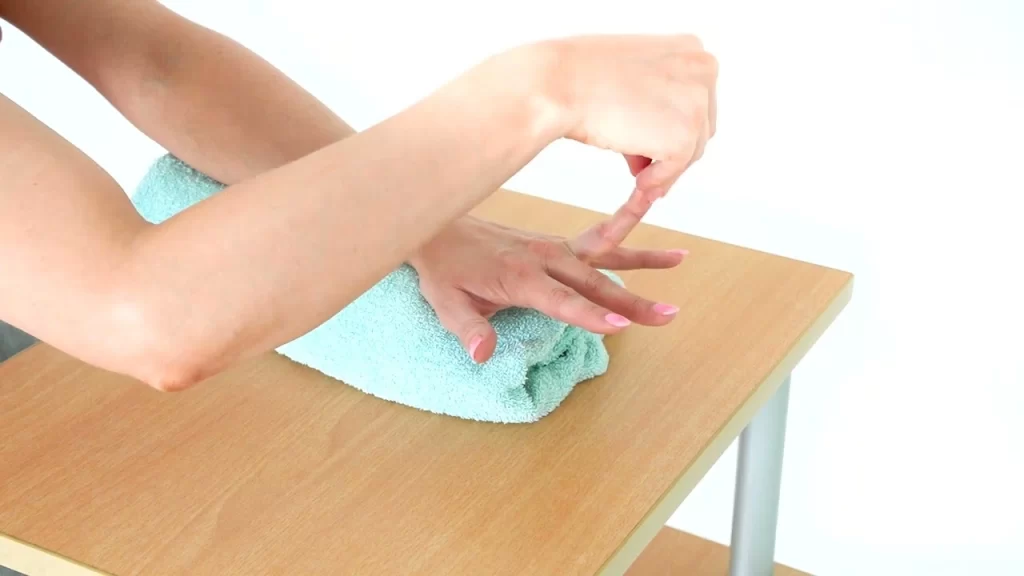
Special Test for Metacarpophalangeal Joint (MCP) Flexion
There are specific specialty tests that health professionals can perform to assess metacarpophalangeal (MCP) joint flexion. Here are some examples:
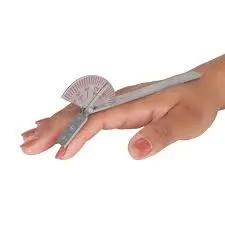
- Modified finger goniometry: This test uses a goniometer, a device that measures joint angles, to assess the flexion range of motion of the MCP joint. A healthcare professional places a goniometer on the finger and measures the angle between the extended finger and the palm while the MCP joint is flexed. This allows objective measurement of the extent of flexion of the MCP joint.
- Kapandji Index: The Kapandji Index is a simple test used to assess the functional range of motion of the MCP joints. The patient is asked to make a full fist so that the fingertips touch the base of the fingers as much as possible. After that, the healthcare worker notes the position of the fingertips in relation to the crease in the palm. The degree of flexion of the MCP joint is assessed by how far the fingertips extend into the palm.
These tests are usually performed by health professionals, such as hand therapists or orthopedists, to evaluate the joint function, monitor the progress of rehabilitation, or diagnose conditions affecting the MCP joint. It is important to consult a health professional if you need a specific evaluation or assessment of MCP joint flexion. They can accurately perform these tests and provide appropriate guidance based on your individual situation.
Metacarpophalangeal Joint (MCP) Extension
What is Metacarpophalangeal Joint (MCP) Extension?
Metacarpophalangeal (MCP) joint extension refers to the straightening movement that occurs between the metacarpal (palmar) and the proximal fingers (phalanx). The MCP joints are located at the base of each finger where the phalanges join the hand.
Extension of the MCP joints allows the fingers to extend or extend away from the palm. This movement is necessary for various hand functions, such as releasing objects, reaching, and creating a flat palm surface for actions such as pushing or grasping.
It is important to note that MCP joint extension is often assessed in conjunction with other finger joint movements, such as MCP joint flexion, interphalangeal joint flexion/extension, and finger abduction/adduction, to assess overall hand function and assess finger limitations or abnormalities. joint mobility.
Metacarpophalangeal Joint (MCP) extensor muscle
The metacarpophalangeal (MCP) joint extensors are the muscles responsible for extending the fingers at the MCP joints. These muscles are located on the back of the hand and forearm. The primary extensor muscles of the MCP joints are:
- Extensor Digitorum: This muscle is located on the forearm and goes along the back of the forearm. It is divided into four tendons that extend to the four fingers (except the thumb). The extensor rectus muscle is responsible for extending the MCP joints and the proximal and distal interphalangeal (PIP and DIP) joints.
- Extensor Digiti Minimi: This muscle is located on the forearm and goes along with the extensor muscle. It extends from the forearm to the little finger. The extensor digit minimi is responsible for extending the MCP joint of the little finger.
- Dorsal Interosseous Muscles: These small muscles are located between the metacarpal bones at the back of the hand. The interosseous muscles of the back help extend the MCP joint and promote the abduction of the fingers. The coordinated action of these muscles allows the MCP joints to expand, allowing the fingers to extend. It is important to note that the extensor tendons of these muscles go along the back of the hand and cross the wrist before reaching the fingers.
Metacarpophalangeal Joint (MCP) Extension ROM
The normal range of motion for extension of the metacarpophalangeal (MCP) joint of the hand is approximately 0-70 degrees. This means that when the hand is in a relaxed, neutral position, the fingers can be extended (extended) slightly flexed (bent) up to about 70 degrees of extension. It is important to note that individual variations in the range of motion may be due to factors such as age, injury, or anatomical differences. If you are concerned about your movement or experience limitation or pain, it is recommended that you consult a doctor for an accurate assessment and proper guidance.
Test For Metacarpophalangeal Joint (MCP) Extension
One simple test to assess metacarpophalangeal (MCP) joint extension is the “finger extension test”. This can be done as follows.
- Start with the palm of your hand on a flat surface, such as a table, with your fingers extended and close together.
- Keep your hands in a relaxed position.
- One by one, lift each finger off the surface while keeping the other fingers in contact with the table.
- Pay attention to the range of motion and any discomfort or difficulty you may have as you lift each finger.
- Compare the expansion area and the ease of movement between the fingers.
During this test, a normal extension of the MCP joint allows each finger to be lifted off the surface without significant limitation or pain. If you experience difficulty or notice limited movement or discomfort in any of your fingers, this may indicate a problem with the MCP joint. In such cases, it is recommended to consult a doctor for a comprehensive evaluation and proper diagnosis.
Metacarpophalangeal Joint (MCP) extension exercise
Here’s an exercise that specifically targets the metacarpophalangeal joint (MCP):
- To begin, sit comfortably at a desk with your arm resting on the desk and your palm down.
- Place a small cloth or soft object such as a sponge under your fingers.
- With your whole hand, gently press the towel to your fingertips, forcing your fingers to stretch.
- Hold the stretched position for about 10 seconds while applying gentle, even pressure.
- Relax and release the tension, allowing the fingers to return to a neutral position. Be sure to perform this exercise with pain-free movements. If you feel discomfort or pain, reduce the intensity or range of motion. Also, make sure you breathe naturally during the exercise. This exercise helps improve MCP joint stretch by providing a gentle stretch and promoting finger range of motion. However, if you have a specific illness or disability, it is always recommended to consult a doctor or certified hand therapist for personal guidance and exercises tailored to your situation.
A special test of Metacarpophalangeal Joint (MCP) extension
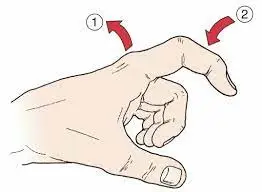
One specific test commonly used to assess metacarpophalangeal (MCP) joint extension is the “Bunnel-Littler test.” This test helps determine if the limitation in the extension of the MCP joints is due to intrinsic muscle tightness or a capsular problem. This can be done as follows.
- Place the patient’s hand, palm down, on a table or examination surface with the wrist slightly extended and the fingers relaxed.
- Stabilize the proximal phalanx of the test finger with one hand just above the MCP joint.
- On the other hand, try to passively extend the distal interphalangeal (DIP) joint while keeping the MCP joint in a neutral position (no extension or flexion).
- Repeat the test, but this time keep the DIP joint flexed (flexed). 5. Compare the results and note any differences in the MCP youth extensions between the two test variants.
Interpretation of the Bunnel-Littler test:
- If the MCP joint can extend more when the DIP joint flexes, this indicates an internal muscle strain.
- If MCP joint extension remains limited regardless of DIP joint position, this indicates capsule or joint retraction.
Summary
Flexion of the MCP joints allows the fingers to bend or curl into the palm. The main MCP flexor muscles are Flexor Digitorum Profundus, Flexor Digitorum Superficialis, and Interosseous muscles. The average range of flexion of the MCP joint is approximately 90 degrees. MCP Flexion Exercises are Flexion Stretch, Rubber finger flexion & Table finger flexion. The special MCP flexion test is Modified finger goniometry.
Extension of the MCP joints allows the fingers to extend or extend away from the palm. The primary extensor muscles of the MCP joints are Extensor Digitorum, Extensor Digiti Minimi, and Dorsal Interosseous Muscles. The normal range of motion for extension of the metacarpophalangeal (MCP) joint of the hand is approximately 0-70 degrees. One specific test commonly used to assess metacarpophalangeal (MCP) joint extension is the “Bunnel-Littler test.” This test helps determine if the limitation in the extension of the MCP joints is due to intrinsic muscle tightness or a capsular problem.
FAQs
In the metatarsal joint, flexion and extension are considered primary movements. The active flexion range of motion is around 90 degrees, while the active extension range is 10 degrees for the index finger and 30 degrees for the little finger.
The MCP joint of the thumb is an articulated joint that allows up to 80-90 degrees of flexion with minimal extension, adduction, or abduction. The MCP joints of digits 2-5 are shallow ball and socket joints that allow flexion, extension, abduction, adduction, and limited abduction.
The extension of the extensor tendon to the extensor head and middle phalanx is the prime mover of the extensor tendon. The MCP joint is extended by torque produced by the extensor tendon, which passes through the force-bearing joint and has an extension-moment shoulder.
The MCP joints have two degrees of freedom and may move in two directions: flexion and extension in the sagittal plane and abduction and adduction in the frontal plane.
Depending on the individual, the endpoint of flexion of the MCP joint may be capsular or bony, and the extension of the MCP joint may be capsular. Capsular tip sensation also occurs with extreme MCP abduction, DIP flexion, thumb IP joint flexion, and extension of all IP joints.

